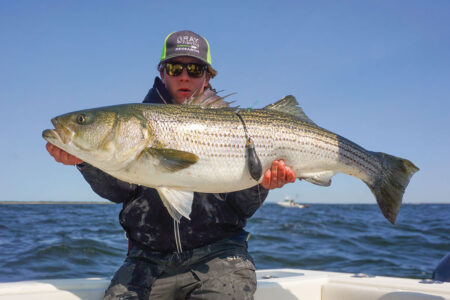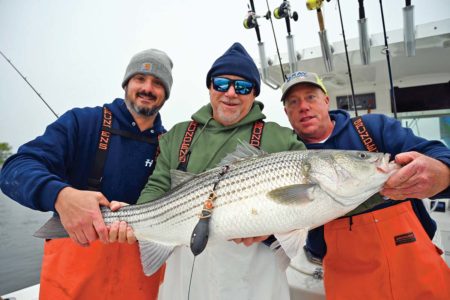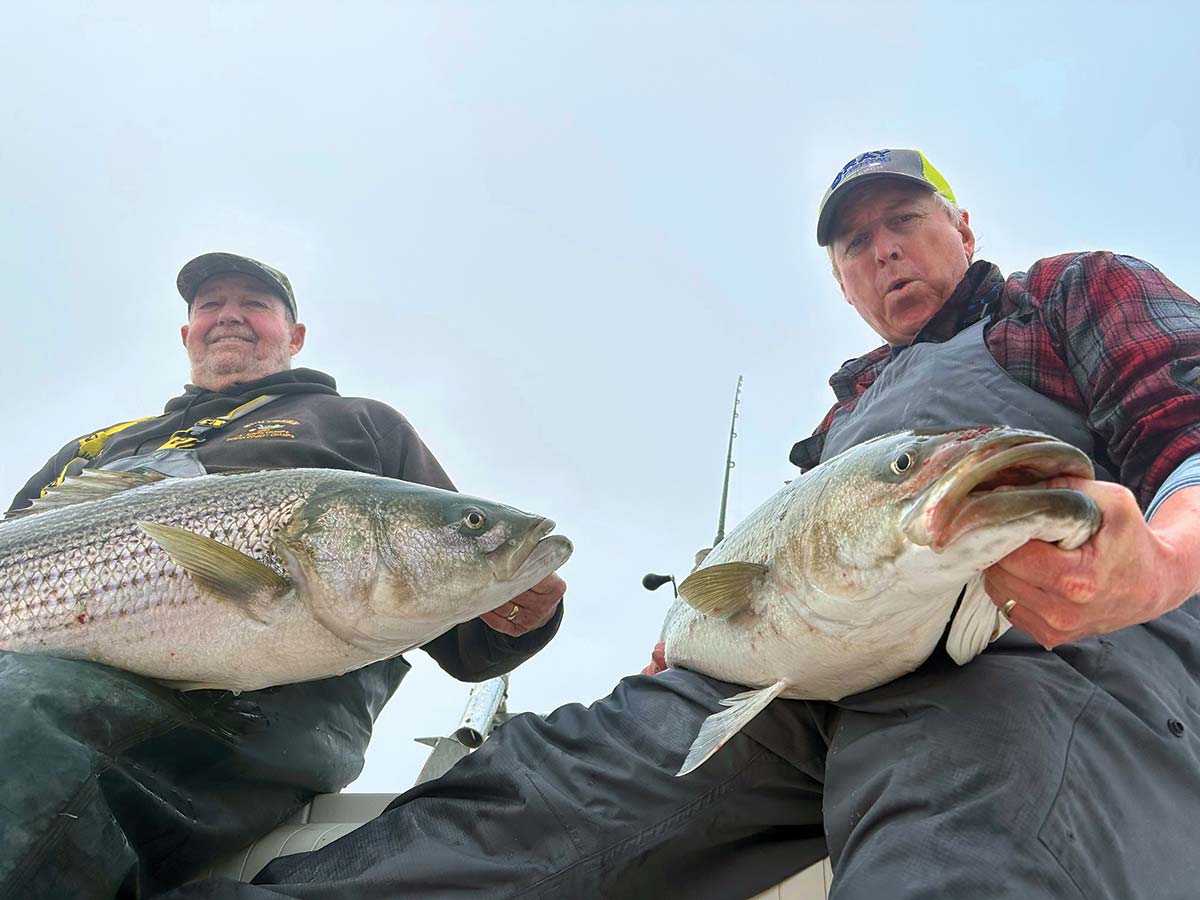
A final fall blitz of tagging in ‘22 helps usher in a new year of striper discoveries for ’23.
“Talk to your dad tonight and let me know what day works for you,” was the text I received from Chuck Many on October 22, 2022. “Forecast looks good Tuesday, Wednesday and or Thursday, but east wind always makes me a little nervous.”
The month prior at The Fisherman’s annual fishing show in Huntington on Long Island, Gray Fishtag Research president Bill Dobbelaer had given me the tag stick and MiniPAT device destined for October deployment off the Jersey Coast. The New York event was a huge success; in addition to collecting another high-tech tracking device, the panel discussion with Dobbelaer, The Fisherman’s Mike Caruso and Capt. Dave Marciano of Wicked Tuna fame generated terrific public response while netting a $1,000 donation from the New York Sportfishing Federation towards our ongoing Northeast Striped Bass Study in 2023.
With the $5,000 MiniPAT device locked tight in my UWK “bulletproof” case, I was chomping at the bit for our final striped bass deployment of 2022 out of Highlands in New Jersey in Chuck’s True World named Tyman which we set for Tuesday, October 25. The day before the trip Chuck texted back “6:45 at the boat tomorrow. I think the ocean will be a little ‘sporty’. Think your dad will be okay?”
Hutch, Sr. turned 79 the month prior, and my best fishing buddy in life was about to join me on another Northeast Striped Bass Study expedition with the best striper fisherman I know. “He’s a go,” I texted back, prompting the legendary Tyman, Ric Flair-like “WOOOOOO!” in return.
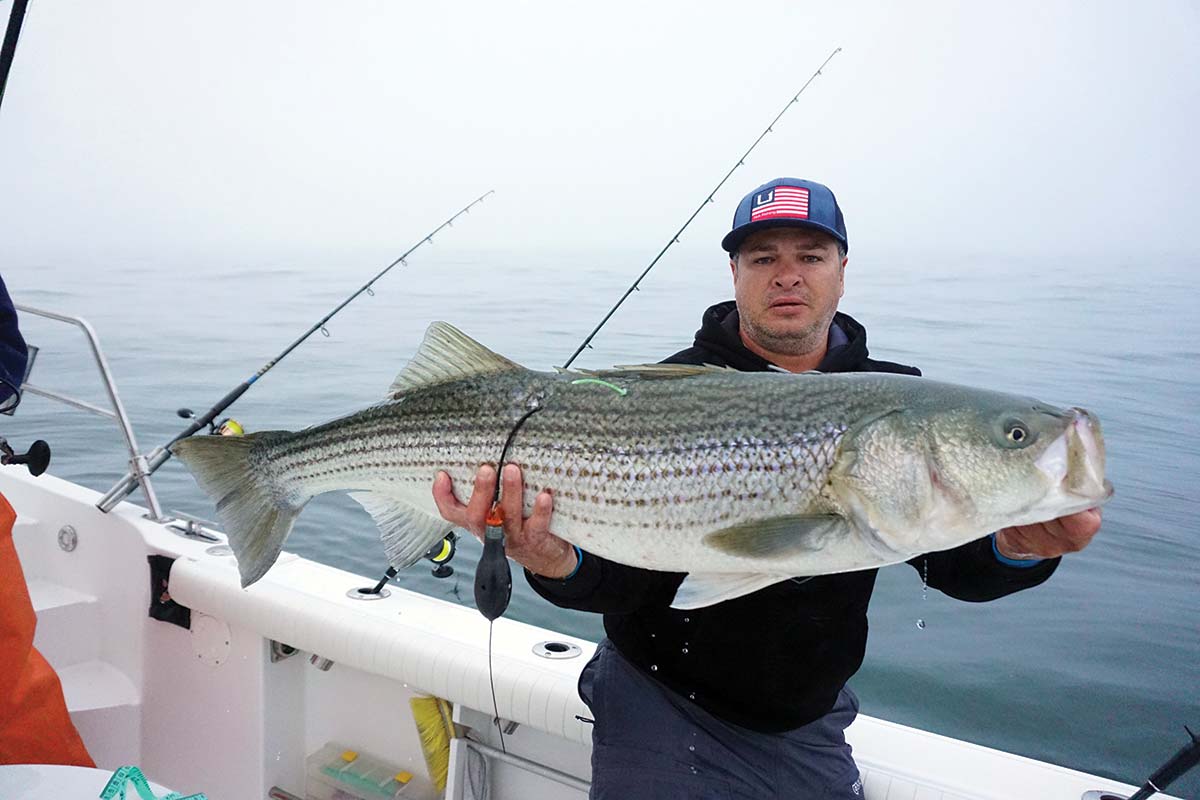
Generational Discoveries
As you may have read in our November, 2022 edition update (Nantucket Shoals: Whales, Doormats & Jumbo Stripers) there were three striped bass fitted with satellite tags during our initial tagging expedition last spring, a 40-inch striped bass named Pappy Jim and 48-inch striper named Van Staal, which were each was caught and released with a MiniPAT attached, and a 48-inch striped bass named Seaguar Striper which was fitted with the new mrPAT. Regrettably, the tags implemented in both Pappy Jim and Seguar Striper came off well premature of the preset time, while the MiniPAT in Van Staal stopped transmitting and sending stored data to the Argos satellite after just one day, well short of its typical battery life.
In addition to the MiniPAT and mrPAT devices designed for larger, 34-inch and over fish, the Washington-based Wildlife Computers sent us two new “field test” satellite tags last summer which have been designed for smaller specimens. On August 18, Capt. Guy Buono and I deployed a microPAT device in a 29-inch striper (N40° 36.486’ / W74° 02.350’) near the Verrazano Bridge; less than three weeks later we had our first sat-tagged striper in New England waters as Caterpillar Marine’s Chris Scanzillo and Tim Geary placed a second microPAT device in a 32-inch striped bass of Massachusetts (N42° 9.569’ / W70° 41.922’) on September 4.
All three devices – the MiniPAT, the mrPAT and the newer microPAT – are programmed with a pre-set date, at which time the release pin burns through, separating the tag from its tether; the buoyant tag then floats to the ocean surface, where a wet/dry sensor triggers the battery, and data stored inside the tag itself begins transmitting to the Argos satellite. The tags themselves archive data on water temperature, pressure and light conditions in onboard memory; in the case of the MiniPAT and microPAT the stored data includes geolocation specifics to map out the path the fish took, while the mrPAT isn’t able to generate that data between point A (where the fish was tagged) and point B (where the tag hit the water’s surface after separating from the fish).
We were hit with less than stellar news when word from Roxanne Willmer at Gray Fishtag Research in Florida came that the Scanzillo/Geary fish tag popped off just off Scituate’s North River in Massachusetts only a month later. “To our surprise it was up the North River a few miles from where we caught the fish and placed the tag,” Scanzillo said. Together with his 13-year-old son Jake, Scanzillo hopped aboard his 18-foot panga for a trip up the North River in search of the tag. “The stretch of river where the tag was pinging is pretty darn amazing, picturesque and probably my favorite stretch of that river,” Scanzillo recalled, adding that by 6:30 p.m. “We passed the edges of the banks and poked and prodded through the grasses hoping to catch a glimpse of this tag and make it home in time for dinner. Not a chance.”
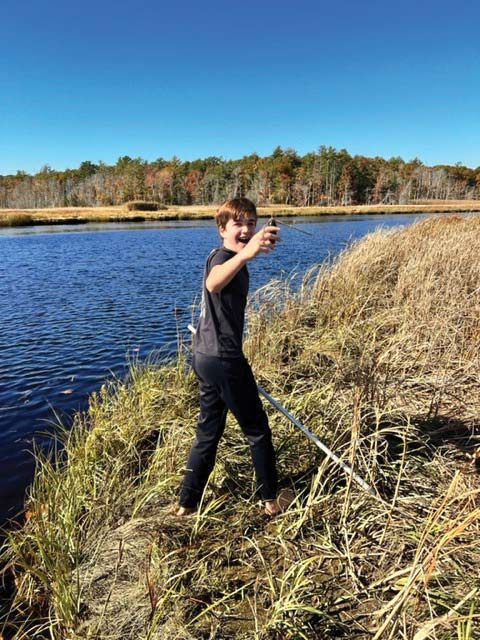
A storm rolled through the next day, and by Saturday the Scanzillo boys were back out on the river looking for the microPAT device. “After several hours of me shifting in and out of gear and Jake lying in his stomach on the bow with a boat hook in his hand poking at grass we began to lose daylight and had to call it a night,” Scanzillo said. Three days later with battery life in the microPAT running out, Wildlife Computers sent a specialized receiver to Scanzillo that could possibly detect the tag’s signal. “The receiver (think walkie talkie) arrived Thursday morning along with an antenna and attenuation filter,” Scanzilllo noted, while explaining how tides, weather and impending sunset did not help in the search. “Roxanne and I spoke and the tag’s voltage was dropping, indicating that there was not much time left when the tag would be transmitting or sending out a signal we could hear with our receiver,” he said.
With the tag still barely connecting to the Argos on Friday, the Scanzillo boys were faced with a choice. “Jake had school and I was supposed to work, but we made the collective decision we would both skip that day because (1) all lessons are not learned in the classroom, (2) “this is literally more important than anything at school Dad,” and (3) there’s nothing more worthy of blowing off work than fishing (of sorts) with your kid.”
Having left at daybreak, Chris and Jake began running out of tide a little before noon. “I reluctantly texted Roxanne and told her we had about another 30 minutes before we had to call it, knowing that this would very likely be our last opportunity and the battery would soon be dead,” Scanzillo said. In a last ditch effort, he reached out to Wildlife Computers to devise a plan to make the search area smaller to the point where father and son could get on their hands and knees to feel every square inch of ground; maxing the gain and attenuation settings on the receiver to get to a roughly 15-foot diameter would do the trick.
“As I’m trying to further work down the area with the receiver and explaining to Jake that we are about to get muddy, Jake is starting to search through the grass again within our targeted area,” the elder Scanzillo noted, adding “After kicking away some dead grass that had clumped up at the high tide mark from (presumably) last Friday’s storm he sees a little piece of black plastic, picks it up and what do you know, he found it!”
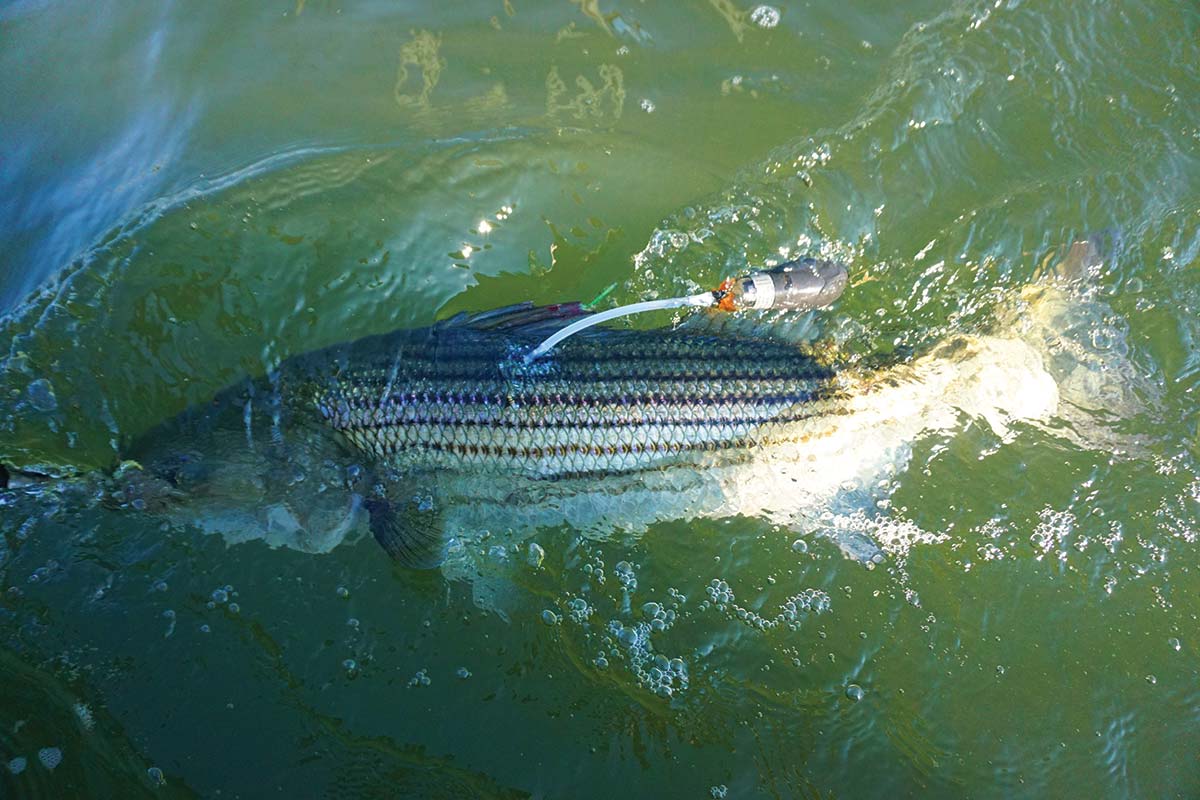
“It was a great ride back, and a great feeling to think that Jake is probably one of a few, if any, people to both catch the fish that is tagged and retrieve the very same tag at a later date,” the elder Scanzillo noted, adding “Definitely a father/son memory for the record books.”
Capt. Buono’s tag by the way, affixed to a 29-inch striper that whacked a Kettle Creek Swing Shad under the Verrazano on August 18, was set to remain in place for 180 days and as far as we know is still apparently intact to the fish; as is the MiniPAT device placed into a 42-inch striper named in honor of Northeast Striped Bass Study supporters Berkeley Striper Club.
The first fish boated that morning of October 25th aboard Tyman was brought aboard by Cesar Carranza; Hutch, Sr. was still battling his first fish when Chuck and I decked Berkeley and slid the MiniPAT into her shoulder. “This one’s ready for the net,” my father said, rod buckled over and the planer swinging back and forth near the gunnel. “Yeah, well keep her tight pop, we’re a little busy right now,” I said with a laugh as we prepped the big striper for release. We would go on to catch a half-dozen or so fish in the 30- to 40-pound range that morning, in pretty bumpy conditions with easterly winds building as the morning wore on. After the trip, I texted Chuck back with my thanks, and much like Scanzillo’s father and son memory for the record books, I said “One of the most memorable trips with my pop of all time.”
In truth, Hutch, Sr. and I don’t fish together as much as I’d really like; still, every time out together seems more special than the one before. Now having a MiniPAT device on one big fish and another half-dozen or so Gray spaghetti tags in others, it will help continue that special day of sorts, a future reminder through tag returns of memories past. “It was nice to tag the fish, but that is what I was hoping for,” Many texted back, acutely adding “Wish I could do that one more time with my dad.” Hopefully, we can share the same experience together as a team again in the fall of 2023 after dad turns 80.
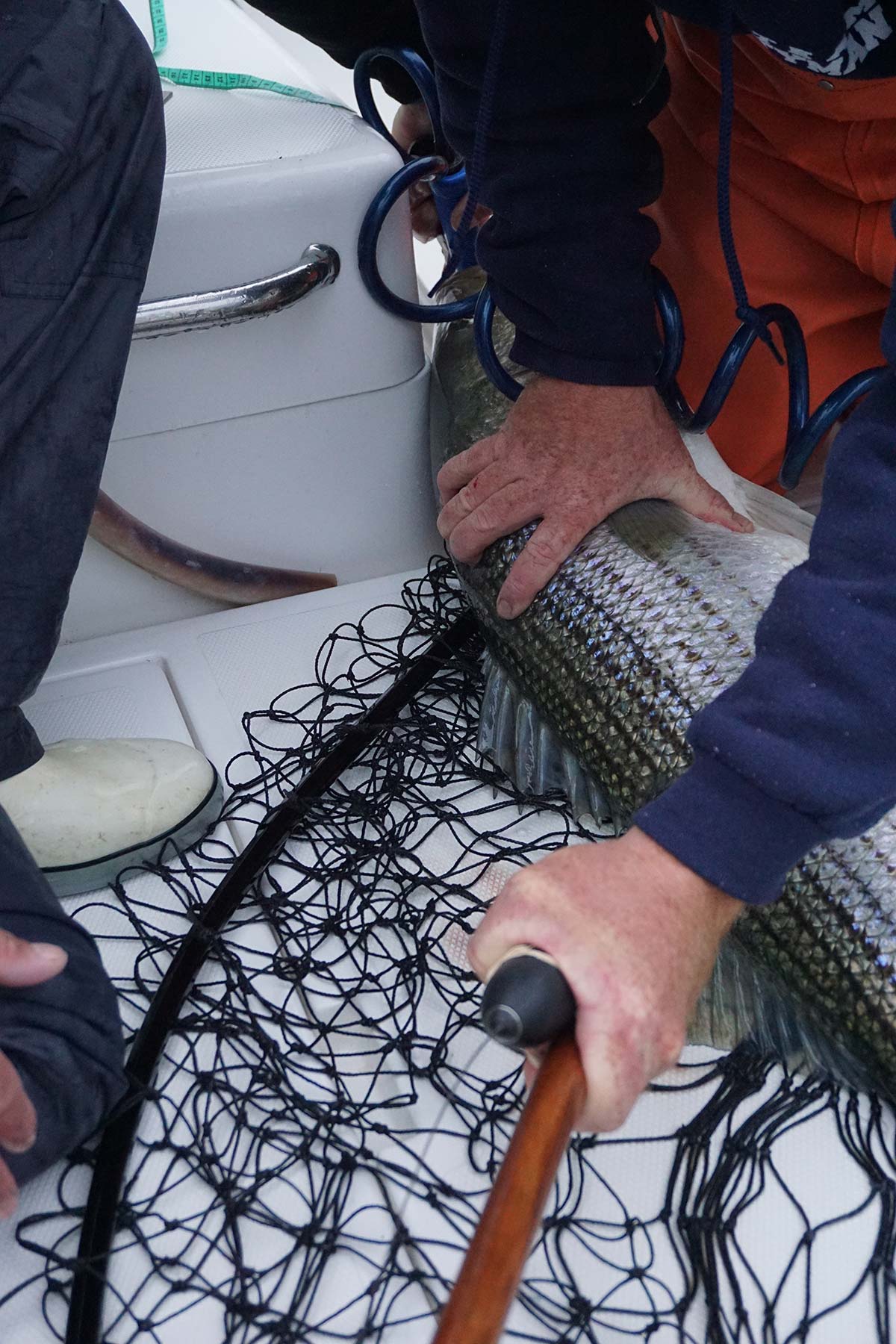
What Do We Really Know?
In November of 2021, my buddy Tom Lynch and I hopped aboard Many’s Tyman for deployment of our sixth MiniPAT device of the year. About a half-hour into our light troll using live eels under planers, Lynch grabbed hold of one of the bent rods and managed a 48-inch striped bass to the net. That jumbo striper we named Uncle Fred in honor of the late Fred Golofaro from The Fisherman would eventually track its way down the Atlantic Coast, apparently weaving back and forth across the three-mile-line before turning into the Chesapeake Bay at Cape Charles, VA in late November. According to data stored inside that device, Uncle Fred stayed inside the Chesapeake west of the lower Delmarva Peninsula for the entire month of December and January.
| ’23 SPONSORS |
| The ongoing Northeast Striped Bass Study partnership with Gray Fishtag Research and The Fisherman would not be possible without the incredible financial support of our sponsors, including American Fishing Wiring (AFW), Berkeley Striper Club, Caterpillar Marine, Fin-Nor, the Fisheries Conservation Trust, Hudson River Fishermen’s Association, LBI Surf Fishing Classic, the Many, Glassberg and Nova families, Montauk Surfcasters Association, New York Sportfishing Federation, PENN, Raritan Bay Anglers Club, Reel Max Life / NJ SAT Fest, Seaguar, Simrad and Van Staal.
To learn more about Gray Fishtag Research and how you can make a tax-deductible charitable donation to the Northeast Striped Bass Study contact Roxanne at 844-824-8353 or [email protected]. |
“In the 90s, I used to bass fish every winter out of Wanchese along the Outer Banks of North Carolina, catch those fish all winter,” Many recounted last year upon publication of Uncle Fred’s path. “Each year however that migration moved north, to the point that I moved the Tyman up to Rudee Inlet in Virginia, and then ultimately to Cape Charles, VA where I’ve been winter striper fishing for the past several years,” he added.
“People always ask me, why do you do all this tagging of striped bass? My response, ‘because we don’t know much about them and what they really do’,” Many told me. As he pointed out in The Fisherman Magazine last May, what we often hear from anglers is what we’ve always been told:
- That 80% of the stock come from the Chesapeake with the rest coming from the Pamlico Sound stock, Hudson & Delaware Rivers.
- How the schoolies live in estuaries near where they were born and don’t migrate until they are larger
- And migrating striped bass are an inshore species that travel along the east coast and summer in New England, wintering off Virginia and North Carolina.
“Sure, those may have been assumed facts in the past, but my personal experiences fishing for striped bass for close to 50 years don’t support them,” Many said. The concept that these jumbo stripers that migrate down the coast in the fall will winter-over off the Carolinas before entering the Chesapeake in early spring doesn’t seem to fit exactly with Uncle Fred’s path of already entering the Chesapeake to winter-over.
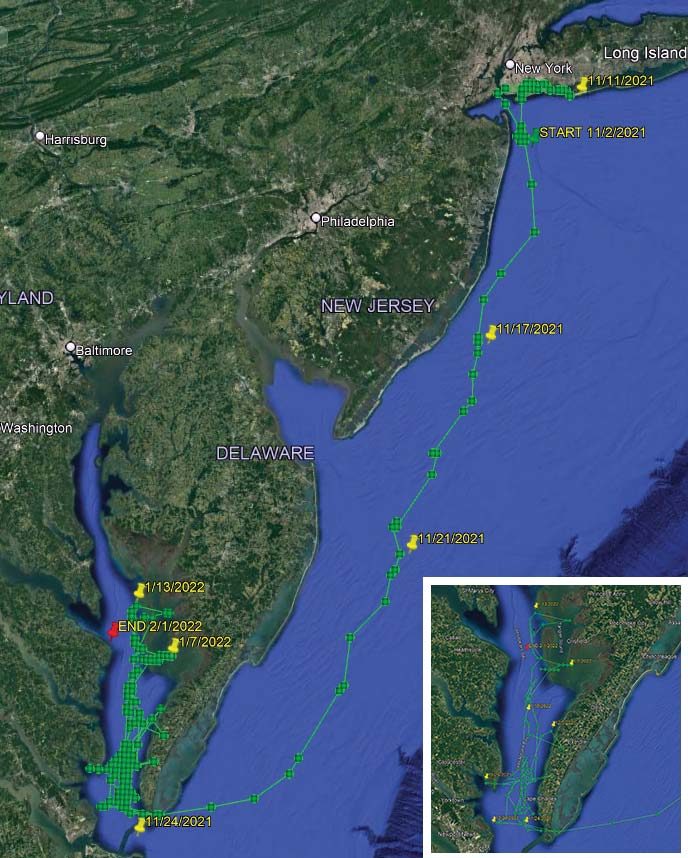
Sometime later this month perhaps, we’ll have data from Berkeley to share with readers later this spring. And then there are the two additional jumbo stripers (fish named Marlin Maniac and Tyman) tagged on December 10 and 11 by Many along with contributor Dave Nova and Clinton Lessard aboard SHO NUF Sportfishing in Chesapeake Bay, in an attempt to close the loop of our tagging activities in the southern region, with a 90-day release. Thinking strategically, we hope to deploy more tags to the north/northeast in 2023, in Rhode Island or Massachusetts, and perhaps in the middle of Long Island Sound with the new support of the New York Sportfishing Federation.
What started with two MiniPSAT tagged stripers in the lower Hudson River during the spring of 2019 continues into 2023. We have new discoveries to make in the coming weeks from tagged fish currently in the mix, and in May of this year we’ll kick off another season of the Northeast Striped Bass study in our fifth year of striped bass tagging.
Stay tuned!

